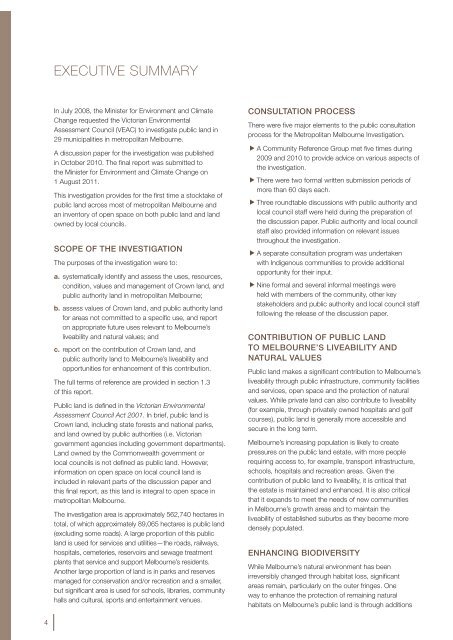Metropolitan Melbourne Investigation - Victorian Environmental ...
Metropolitan Melbourne Investigation - Victorian Environmental ...
Metropolitan Melbourne Investigation - Victorian Environmental ...
You also want an ePaper? Increase the reach of your titles
YUMPU automatically turns print PDFs into web optimized ePapers that Google loves.
EXECUTIVE SUMMARY<br />
In July 2008, the Minister for Environment and Climate<br />
Change requested the <strong>Victorian</strong> <strong>Environmental</strong><br />
Assessment Council (VEAC) to investigate public land in<br />
29 municipalities in metropolitan <strong>Melbourne</strong>.<br />
A discussion paper for the investigation was published<br />
in October 2010. The final report was submitted to<br />
the Minister for Environment and Climate Change on<br />
1 August 2011.<br />
This investigation provides for the first time a stocktake of<br />
public land across most of metropolitan <strong>Melbourne</strong> and<br />
an inventory of open space on both public land and land<br />
owned by local councils.<br />
SCOPE OF THE INVESTIGATION<br />
The purposes of the investigation were to:<br />
a. systematically identify and assess the uses, resources,<br />
condition, values and management of Crown land, and<br />
public authority land in metropolitan <strong>Melbourne</strong>;<br />
b. assess values of Crown land, and public authority land<br />
for areas not committed to a specific use, and report<br />
on appropriate future uses relevant to <strong>Melbourne</strong>’s<br />
liveability and natural values; and<br />
c. report on the contribution of Crown land, and<br />
public authority land to <strong>Melbourne</strong>’s liveability and<br />
opportunities for enhancement of this contribution.<br />
The full terms of reference are provided in section 1.3<br />
of this report.<br />
Public land is defined in the <strong>Victorian</strong> <strong>Environmental</strong><br />
Assessment Council Act 2001. In brief, public land is<br />
Crown land, including state forests and national parks,<br />
and land owned by public authorities (i.e. <strong>Victorian</strong><br />
government agencies including government departments).<br />
Land owned by the Commonwealth government or<br />
local councils is not defined as public land. However,<br />
information on open space on local council land is<br />
included in relevant parts of the discussion paper and<br />
this final report, as this land is integral to open space in<br />
metropolitan <strong>Melbourne</strong>.<br />
The investigation area is approximately 562,740 hectares in<br />
total, of which approximately 89,065 hectares is public land<br />
(excluding some roads). A large proportion of this public<br />
land is used for services and utilities—the roads, railways,<br />
hospitals, cemeteries, reservoirs and sewage treatment<br />
plants that service and support <strong>Melbourne</strong>’s residents.<br />
Another large proportion of land is in parks and reserves<br />
managed for conservation and/or recreation and a smaller,<br />
but significant area is used for schools, libraries, community<br />
halls and cultural, sports and entertainment venues.<br />
CONSULTATION PROCESS<br />
There were five major elements to the public consultation<br />
process for the <strong>Metropolitan</strong> <strong>Melbourne</strong> <strong>Investigation</strong>.<br />
G A Community Reference Group met five times during<br />
2009 and 2010 to provide advice on various aspects of<br />
the investigation.<br />
G There were two formal written submission periods of<br />
more than 60 days each.<br />
G Three roundtable discussions with public authority and<br />
local council staff were held during the preparation of<br />
the discussion paper. Public authority and local council<br />
staff also provided information on relevant issues<br />
throughout the investigation.<br />
G A separate consultation program was undertaken<br />
with Indigenous communities to provide additional<br />
opportunity for their input.<br />
G Nine formal and several informal meetings were<br />
held with members of the community, other key<br />
stakeholders and public authority and local council staff<br />
following the release of the discussion paper.<br />
CONTRIBUTION OF PUBLIC LAND<br />
TO MELBOURNE’S LIVEABILITY AND<br />
NATURAL VALUES<br />
Public land makes a significant contribution to <strong>Melbourne</strong>’s<br />
liveability through public infrastructure, community facilities<br />
and services, open space and the protection of natural<br />
values. While private land can also contribute to liveability<br />
(for example, through privately owned hospitals and golf<br />
courses), public land is generally more accessible and<br />
secure in the long term.<br />
<strong>Melbourne</strong>’s increasing population is likely to create<br />
pressures on the public land estate, with more people<br />
requiring access to, for example, transport infrastructure,<br />
schools, hospitals and recreation areas. Given the<br />
contribution of public land to liveability, it is critical that<br />
the estate is maintained and enhanced. It is also critical<br />
that it expands to meet the needs of new communities<br />
in <strong>Melbourne</strong>’s growth areas and to maintain the<br />
liveability of established suburbs as they become more<br />
densely populated.<br />
ENHANCING BIODIVERSITY<br />
While <strong>Melbourne</strong>’s natural environment has been<br />
irreversibly changed through habitat loss, significant<br />
areas remain, particularly on the outer fringes. One<br />
way to enhance the protection of remaining natural<br />
habitats on <strong>Melbourne</strong>’s public land is through additions<br />
4
















